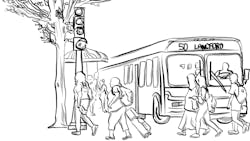Bus networks throughout North America are seeing growth on a variety of fronts. According to the American Public Transportation Association’s (APTA) “Public Transportation Ridership Report” for Q4 in 2024, total bus ridership increased by 9.24 percent compared to total ridership in 2023. This builds on the 16 percent increase in ridership from 2023 compared to 2022, according to a policy brief APTA released in April 2024. In the same brief, APTA cites national public transit ridership has reached 79 percent of pre-pandemic levels.
As ridership comes back to transit systems, agencies are investing in their bus fleets. Over a dozen of bus orders have been announced since the start of the new year, with many orders including low- or zero-emission vehicles. This follows the data from Mass Transit’s “2025 Mobility Outlook Survey,” where 40 percent of respondents said their bus fleets needed the most immediate investment. Several high-profile bus projects have also made strides in the past year, with IndyGo launching the Purple Line, its second bus rapid transit (BRT) route; Seattle Department of Transportation breaking ground on its RapidRide J Line; and the Port Authority of New York and New Jersey moving ahead with its Midtown Bus Terminal replacement project after securing federal funding.
Navigating a delicate supply chain
While APTA is reporting 2,094 rubber-tired vehicles are on order as of Jan. 1, 2024, according to its 2024 Vehicle Database, fulfilling these orders may come with some hurdles. U.S. bus manufacturing and the larger North American transit bus supply chain has already been experiencing challenges, with several original equipment manufacturers (OEMS) having already or about to close operations. Nova Bus sold its Plattsburgh, N.Y., plant at the end of 2024 while REV Group sold ENC in October 2024. However, new players are entering the market, with Solaris signing its first contract in the U.S. market for an electric bus order and Micro Bird setting up manufacturing operations in Nova Bus’ New York plant.
Adding manufacturers is one step to build resiliency into the supply chain. Other steps being taken include the Federal Transit Administration's (FTA) proposed Buy America Waiver for Battery Electric Minibuses, which ended the comment period early January 2025. This follows FTA’s extension of the Partial Buy America Waiver for Vans and Minivans, which was originally granted in 2022. APTA also continues to leverage the recommendations from the Bus Manufacturing Task Force, which encourages agencies entering contracts to consider adding in price adjustments in contracts, implementing progress payments and including vehicle price adjustment mechanisms to account for inflation or deflation throughout the contract lifecycle.
In line with these recommendations, a couple of agencies took steps last year to help streamline the procurement process. The Los Angeles County Metropolitan Transportation Authority (L.A. Metro) Board of Directors adopted a policy that requires all future bus procurements to minimize customization specifications and introduce new and early milestone payments. The policy also encourages other local bus agencies to participate. L.A. Metro’s Regional Zero-Emission Bus Procurement policy is meant to provide relief to OEMs.
The Jacksonville Transportation Authority (JTA) Board of Directors approved a similar measure, allowing the JTA to award and negotiate a statewide contract to purchase autonomous vehicles (AVs). The statewide procurement is in partnership with the Florida Public Transportation Association (FPTA), which allows its members to select from shortlisted companies, after due diligence, that qualified through their compliance with specific operational requirements. This effort helped standardize and streamline AV procurements throughout the state.
One other thing to watch for will be how the onslaught of tariffs and counter-tariffs will impact current and future bus orders. The private sector was already bracing for cost increases. In the “2025 Mobility Outlook Survey,” 26 percent of respondents cited inflation as their top concern going into 2025.
Industry continues to pursue the zero-emission transition
According to APTA’s 2024 Vehicle Database, 44 percent of active rubber-tired vehicles in the U.S. are using alternative power. This number will continue to grow. Forty-seven percent of transit agency respondents to the “2025 Mobility Outlook Survey” said they planned to procure battery-electric buses (BEBs). That is compared to the 30 percent of respondents who plan to procure diesel buses.
This increase in alternative fuel and zero-emissions bus (ZEB) adoption is in line with CALSTART’s “2025 Zeroing in on ZEBS” annual report. According to the report, adoption of full-size ZEBs increased 14 percent compared to 2023. While BEBs make up the bulk of these vehicles, adoption of fuel cell electric buses increased by 55 percent compared to 2023. Small ZEBS also saw an increased adoption rate of 25 percent compared to 2023. CALSTART’s report calculates the U.S. will surpass 15,000 full-size ZEBS by 2030 if the industry continues this pace of adoption.
Helping fund this adoption is the FTA’s Low- and No-Emission Grant program and the Bus and Bus Facilities Grant program. In fiscal year 2024, over 100 projects across the county received nearly $1.5 billion in funding from these programs. Projects awarded will use the funds to purchase hydrogen fuel-cell buses, BEBs, charging equipment and modernized facilities to support the new vehicles. According to CALSTART’s report, this funding supported the purchase of nearly 600 ZEBs in 2024.
About the Author
Megan Perrero
Editor in Chief
Megan Perrero is a national award-winning B2B journalist and lover of all things transit. Currently, she is the Editor in Chief of Mass Transit magazine, where she develops and leads a multi-channel editorial strategy while reporting on the North American public transit industry.
Prior to her position with Mass Transit, Perrero was the senior communications and external relations specialist for the Shared-Use Mobility Center, where she was responsible for helping develop internal/external communications, plan the National Shared Mobility Summit and manage brand strategy and marketing campaigns.
Perrero serves as the board secretary for Latinos In Transit and is a member of the American Public Transportation Association Marketing and Communications Committee. She holds a bachelor’s degree in multimedia journalism with a concentration in magazine writing and a minor in public relations from Columbia College Chicago.

